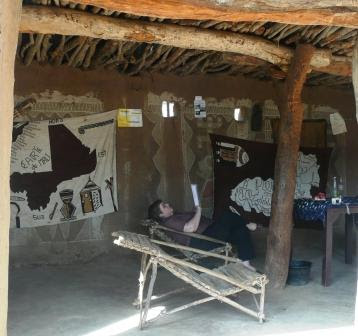We had a continental breakfast in the courtyard of the Motel Severe. The bread in Mali, always baguettes, is wonderful! Then we hired ourselves an accredited guide (no escaping that) and set off for Dogon country. The Dogon area is the most visited in Mali. To quote the Bradt Travel Guide, “There are about 350,000 Dogon people living on the plateau, cliffs and plain of an area in the south of the administrative region of Mopti.”
We saw a number of naturally occuring lily ponds
Onion fields
The countryside was quite lovely and we saw many naturally occurring lily ponds and onion fields. Onions are an important crop here. I saw a man watering his onion field with two calabashes and couldn’t help wondering why he didn’t make his life easier by using two plastic buckets. These onions are ground into a paste, rolled into balls and sold as far afield as Cote d’Ivoire.
My shoes and swollen feet causing great interest
Inside the old man's hut. Note the holes for the
'bao' game in the floor
In the village we were ushered into a low hut where two extremely old men were sitting on the floor making ropes from twine. We were told to take a seat on a bench and then we talked to the one old man through the interpreter. He pointed to his eyes and said he needed medicine. We explained that we didn’t have any eye-drops, but he shook his head and pointed to Ian’s glasses and told us that that was what he needed. Only then did I see that his eyes had cataracts. What the poor old man needed was not spectacles, but a simple eye op. He had such a sweet, wrinkled old face, and it made us feel wretched that such a simple thing was quite impossible. Both my father and Ian’s have had these ops and it made a huge difference to them. I also noticed that he had deep scars all down both legs, so I asked the interpreter if it was permissible to ask him about them? He then told us that the old man said that he’d got them from fighting as a young man.
The other thing that was quite remarkable about that hut was how cool it was in the midday heat! The floor was rock, the very low ceiling of branches and some covering,and the top of the roof high and conical. Cut into the stone floor was a game that is played all over Africa and which we know as ‘bao’ (pronounced as in the 'bow' of a boat) from our travels in Malawi.
View from the escarpment down
onto Dogon country
After that we drove down a mountain pass to the escarpment below. Once again the scenery was quite spectacular. From one part of the pass we got our first glimpse of the Dogon cliff dwellings which are no longer inhabited but are still maintained and used for some ceremonial purposes. The people used to sleep in the caves on the side of the cliff (some say for security from marauders, others for protection from lions and hyenas) and then they built their granaries just in front of the caves clinging perilously to the side of the cliffs. They are a unique, amazing sight! later that afternoon Ian and the guide climbed up to them and went into the caves which he said were claustrophobic.
Old Dogon cliff dwellings
A closer view of the cliff dwellings
All the baobab trees had been scarified
like this in every Dogon village
Some villages had beautiful mud mosques. Note the
protected baby mango tree in the foreground
After being taken to the village where the men dye the mud-cloth (unusual as most books say that it's the women who dye the cloth - and this time firmly resisting buying yet another one), we were finally taken to yet another village for lunch. Some other tourists were there, too, as well as three young French school teachers who were living in the village for three months and teaching there. Apparently this happens every year. When I saw the Spartan living arrangements, I was impressed by their dedication, I can tell you! Tourists also stay there as this place was an ‘hotel’. There were mattresses and mosquito nets on all the roofs and Spartan rooms with a thin mattress on the floor. The toilet and showers were roofless and the toilet had the usual cement floor with a hole in it.
Lunch was a delicious chicken and tomatoe stew in a
Dogon village with our driver and guide
Ian commented that it was a pleasure to eat such a delicious
meal made from scratch with home grown ingredients
Siesta time in the same village
Yours truly relaxing
It was a wonderfully relaxing place to have lunch - we had a delicious chicken stew on rice for lunch made with potatoes, tomatoes, aubergines, garlic and onions, then watermelon afterwards. There were chairs made from bamboo that you could lie back in, and they even offered us a one inch foam mattress to lie down on, and several people availed themselves of this offer. The courtyard had the mellow vibe of a 1960’s hippie commune. After lunch everyone settled down to rest until 3pm, as our guide said it was too hot to do anything before that. I had to agree with him!














No comments:
Post a Comment